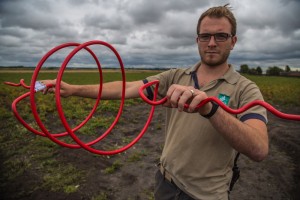Power up for World Migratory Bird Day

More of our homes are being powered in a bird-friendly way due to WWT and its supporters.
This weekend is World Migratory Bird Day, which is urging people across the world to embrace bird-friendly energy.
WWT are showing how that can be done. At WWT Martin Mere Wetland Centre, we’re working with the local electricity company to research flight lines of birds and to hang deflectors at key points on power lines to reduce collisions - as per the photo. Early results suggest collisions could have halved.
Meanwhile at Steart Marshes and at Welney Wetland Centre, we’ve worked with electricity providers to bury power lines underground at collision hotspots. Further east in the North Sea, we’re tracking swan migratory routes and flight heights, to help plan offshore wind farms that won’t get in their way.
WWT’s Head of Campaigns, Peter Morris said:
“Our thirst for energy is throwing up all sorts of barriers for migratory birds - like power lines, chimneys or turbines. But we don’t have to choose between energy or birds. By looking at where the birds go, it can be quite easy to plan our power infrastructure around them.
“It’s all about working with the natural world around us, rather than against it. We all want to keep the hot shower, hot food or a good film that we love and for which we need electricity. With WWT’s help, we can also keep the migratory birds that a million visitors love to see at our wetland centres every year.”
Power lines are a major cause of death for migratory birds, with an average of 100,000 collisions per year in the Africa-Eurasia region of which around 10 per cent are electrocuted. Larger species like swans and geese are particularly susceptible because they’re less able to swerve quickly enough.
Nearly a quarter of the world’s bird species are migratory and 317 migratory species are considered threatened or near threatened. World Migratory Bird Day aims to raise awareness of issues that affect these birds.
The campaign is organised by two international wildlife treaties administered by the United Nations Environment Programme (UNEP) – the Convention on the Conservation of Migratory Species of Wild Animals (CMS), and the Agreement on the Conservation of African-Eurasian Migratory Waterbirds (AEWA).

